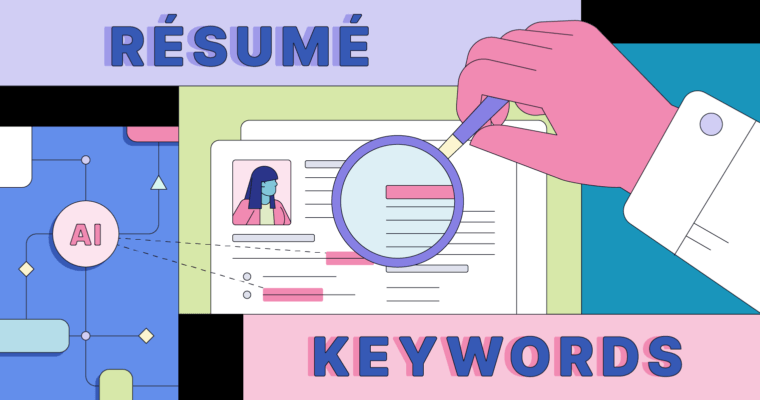
With the rise of artificial intelligence (AI), creating a standout résumé has become, in many cases, a technical art form. Résumés are no longer a simple one-page outline of your job history, skills, and accolades. Now, technology uses keyword searches in résumés to help vet candidates.
This technology is called an applicant tracking system (ATS). Companies use an ATS to save time and weed out candidates that aren’t a good fit for their job description. In this guide, we’ll cover how to find and use keywords to make your résumé stand out to humans and computers alike.
How have résumés changed?
Advancements in technology over the past decade have completely changed the way we search for jobs, apply for jobs, and write résumés. All-in-one talent management platforms have made it so that companies can list a job, scan applications with AI, and set up interviews all in one place on the web.
Résumé keywords are now an important part of getting your résumé into the human hands of employers. Did you know that 75 percent of large companies are using AI to filter résumés? And that 70 percent of résumés never make it to the employer’s desk?
Once a résumé does make it into the human hands of a hiring manager, they’re likely to skim the résumé for keywords as well. Keywords are king in the modern job search.
What is the AI (and a recruiter) looking for?
When an employer posts a job, they input keywords into the ATS. When you submit your application, the ATS scans your résumé.
Recruiters and hiring managers have to sort through hundreds, sometimes thousands, of résumés. Instead of reading each of these résumés, they rely on ATS to filter out the ones that don’t appear to be a good fit.
They program the ATS to scan for keywords from the job requirements. Once the résumé are filtered, a recruiter or hiring manager then gives each résumé a cursory glance. They’re looking at the candidate’s qualifications, skills, work experience, and career progression.
What are résumé keywords and phrases?
Résumé keywords and phrases are the specific words or phrases that a recruiter has told an ATS to look for. Keywords can be skills, credentials, or prerequisites that the job requires.
You should write your résumé first. For each job you apply for, make a copy of your résumé. Then, update the words that are already on your résumé to incorporate the keywords to match the job description. Now, let’s dive into how you can find the right keywords to include in your résumé.
How to find keywords to use in your résumé
Candidates can find keywords in three places: within the job listing, on LinkedIn, and on a company’s website. These keywords will fall into four categories: job-related skills, action verbs, education requirements, and relevant experience.
Where to find keywords:
- Within the job listing: Keywords will be sprinkled throughout the job listing, especially in the “qualifications” and “responsibilities” sections.
- On employees’ LinkedIn profiles: See how employees in a similar position at that company talk about their skills and responsibilities on their LinkedIn page.
- On the company’s website: Look for how they talk about their company on the about page to see how you can speak to them in their own words.
Types of keywords:
- Job-related skills: hard skills, soft skills, and core qualifications
- Action verbs: accomplishments and leadership expectations
- Education requirements: college degrees, high school diplomas, industry certifications
- Relevant experience: job titles you may have had in the past that the employer is seeking
When you’re rounding up the keywords that you want to include in your résumé, pay attention to the tense and format of the skills, nouns, verbs, and job titles listed. The majority of ATS do not understand synonyms, abbreviations, plurals, or similar skills. They only look for exactly what they’re been programmed to find.
For example, Adobe’s creative software could be called “Adobe Creative Suite,” “Adobe CS,” “Adobe CC,” or “Adobe Creative Cloud.” Further, the job description could list out each individual Adobe tool that they’re looking for, including “Adobe Photoshop,” “Adobe XD,” or “Adobe Illustrator.” They may even just call it “Photoshop,” “XD,” or “Illustrator.” Pay attention to how they phrased the tools they’re looking for.
This is also true for verbs and non-proper nouns. The words “managed,” “managing,” “manager,” and “management” may sound the same to you, but to an ATS they’re all different. Depending on how it was programmed, it may only be looking for “manager.” Your résumé may say “managed projects” but the ATS is looking for “project manager.”
It’s OK to alter your job titles, descriptions, and skills to match the way a keyword is listed in a job description as long as the skills were similar. For example, the job may be looking for “content writer,” but your résumé lists “content creator.” Or you may be a “front-end developer” but the job description clearly states “JavaScript developer.”
How to create an ATS-friendly résumé template
ATS can’t read through shading, they don’t understand images, and most recognize certain fonts better than others. Many also read your résumé hierarchically. To make sure your résumé makes it through the system clearly, use or create a template for your résumé that the ATS can read. To create an ATS-friendly résumé template, include the following elements.
Use fonts that ATS can read
- Arial
- Tahoma
- Impact
- Georgia
- Courier
- Lucinda
- Trebuchet
Put your contact information at the top
If you include your contact information at the bottom of your résumé, the ATS may think that you did not include that information. This will may lead to your résumé getting thrown out.
Include these sections
The most important sections the ATS and employers will be looking for are overviews of the requirements in the job description.
Be sure to include these sections to get noticed:
- Contact
- Professional Summary (2–3 sentences)
- Skills
- Work Experience
- Education
Other optional sections
In some industries, it may benefit you to include additional sections to show skills or certifications that you possess.
- Split your technical skills and soft skills into two sections
- Training and certifications
- Honors and awards
- Languages you speak
- Proficiency levels for skills or languages
- Organizations
- Interests
- Social media or portfolio links
How to incorporate keywords in your résumé
Now that you know which types of keywords to look for and where to find them, it’s time to incorporate them into your résumé. Before you spend time adding them to your résumé, make sure you’re using a template that ATS can actually read.
How to incorporate relevant keywords for ATS
Once you have an ATS-friendly résumé template and you’ve rounded up relevant keywords, it’s time to add those keywords to your résumé. Make sure you spell your keywords correctly! The ATS will not understand misspelled words. Use Grammarly to search for spelling and punctuation mistakes in your document before you submit your résumé.
Job-related skills keywords will go in the “skills” section of your résumé. Relevant experience keywords fit into “work experience.” Action verbs also go within “work experience.” They should be incorporated into the descriptions of your previous jobs. Educational requirements should be included in the “education” section.
How to incorporate keywords for recruiters
The ultimate goal is for your résumé to reach a human, though a human probably won’t read your résumé line by line either. They’ll be looking for keywords as well, but they need to be able to read them easily.
It’s still important to make résumé keywords actually fit in an easily readable way. While the ATS doesn’t care how long your résumé is, a recruiter does. Keep your résumé to one page.
Most importantly, recruiters will be scanning for the keywords they programmed the ATS to look for and verifying your certifications. Hiring managers also want to see that you’ve grown throughout your career and that you’re willing to advance your skills and knowledge.
Examples
Here are two practical examples of how to choose the right résumé keywords and incorporate them. In this section, we’re focusing on job-related skills and action verbs. We’ve put the most powerful résumé keywords in bold in both the job description and résumé copy so that you can see exactly how to find and use résumé keywords yourself.
Graphic Designer
This position is for a company that specializes in research and technology for the life sciences industry.
Job description:
RESPONSIBILITIES
- Use all Adobe CC applications to conceptualize and execute the fast-paced environment
- Creative problem-solving skills and execution of new and existing PowerPoint presentations, templates and slide libraries
- Handle various ad-hoc design requests from multiple teams throughout the organization while adhering to the project objectives and milestones
- Ability to conceptualize and present innovative design concepts to team and management
- Execution of digital designs including infographics, iconography, photography, banner imagery and understanding of similar best-practices
- Deliver various web visuals and imagery in alignment with our standards while experimenting with new solutions
- Design and program interactive website modules using Ceros and similar tools
Example résumé copy:
Designed mockups using Adobe CC applications and created website modules with Ceros. Collaborated with email marketing specialist to build innovative new PowerPoint templates in Hubspot. Executed digital designs including web visuals, email graphics, and social media graphics.
Lifecycle Marketing Manager
This Grammarly job opening focuses on customer retention, monetization, and product engagement.
Job description: Demonstrates the ability to synthesize quantitative and qualitative data, balance goals as a factor for decision-making, and use directional data to identify gaps and opportunities. Has a strong handle on experiments, specifically in devising sound and enlightening experiments despite incomplete data. Fosters mutual feelings of support inside and outside of the Lifecycle team. Seamlessly aligns stakeholders, details, and timelines toward a specific goal. Thrives in working with both quantitative and qualitative data.
Example résumé copy:
Managed dozens of projects involving quantitative and qualitative data to direct successful outcomes for my company. Ran quarterly experiments with varying timelines to determine the best path forward for our product. Collaborated with team members to find innovative data-driven solutions.
Data Architect
A data architect with this hospitality company will innovate technological solutions to meet customer needs.
Job description:
We believe the success in this role will demonstrate itself through the following attributes and skills:
- Expertise in Big Data, Hadoop, Data Lakes, Cloud Services, Platform as a Service, Infrastructure as a Service
- Hands-on experience with AWS RedShift, AWS Aurora, AWS EMR, AWS S3, AWS SageMaker
- Experience with MySQL and PostgreSQL
- Experience in Conceptual, Logical, and Physical data modeling
- Experience in metadata capture and management
- Experience with Apache Spark, Apache NiFi, Apache Kafka, Python, LINUX scripting
- Experience with Master Data Management
- Experience with ETL and EL technologies
- Accomplished in software/platform design principles
- Skilled at understanding, documenting, and describing complex technical subjects; and aligning business capabilities to Technology solutions
Example résumé copy:
Used all AWS products including AWS RedShift, AWS Aurora, AWS EMR, AWS S3, AWS SageMaker to store, process, and handle Big Data. Built blog back ends with Python and MySQL. Compared Hadoop, AWS Aurora, and Apache Spark to optimize processing and storage. Daily responsibilities included Conceptual, Logical, and Physical data modeling, Master Data Management, and documenting.






